
Safe Lifting Solutions for Paper and Pulp Manufacturing
Introduction:
Lifting operations within the paper and pulp manufacturing sector involve more than simply handling heavy loads. Operations must accommodate dynamic factors such as load shape, material fragility, environmental conditions, and spatial constraints. Paper rolls and pulp bales often weigh several tonnes and require specialised lifting apparatus to ensure safe, efficient handling. Compliance with LOLER and PUWER regulations, combined with appropriate equipment selection and routine inspection, is critical to minimising mechanical failures, safety risks, and operational downtime.
Key Lifting Challenges in Paper and Pulp Facilities
Cylindrical and Unstable Load Profiles
Paper reels present significant handling complexity due to their geometry and potential for dynamic movement during lifting, increasing the risk of load displacement and equipment overload.
Particulate Contamination
Fine paper dust accumulation can degrade the performance of lifting clamps, grips, and hoists by reducing friction and accelerating mechanical wear.
Restricted Operational Environments
Confined handling zones such as storage mezzanines or production-floor passageways limit crane or hoist manoeuvrability, requiring precise lift planning and load path control.
Corrosive Exposure Conditions
High-humidity environments—particularly near pulping and drying systems—can initiate surface corrosion on lifting assemblies, compromising load integrity and structural strength over time.
Recommended Lifting Equipment for Paper Manufacturing Applications
Specialised Paper Roll Lifters and Hydraulic Clamps
Engineered to conform to cylindrical load profiles, these attachments deliver uniform load distribution and enhanced surface contact, reducing slippage and structural deformation.
High-Capacity Slings (Synthetic or Chain-Based)
Select slings with appropriate Working Load Limits (WLL) and abrasion resistance. Rubber-lined or coated variants improve grip on smooth-surfaced paper rolls.
Galvanised or Polymer-Coated Wire Ropes
Anti-corrosion finishes extend service life in high-moisture settings, such as near pulp vats and wet pressing sections.
Spreader Beams and Multi-Point Lift Frames
These devices ensure balanced load distribution when lifting wide or bundled materials, such as bale stacks or palletised paper units.
Inspection & Preventative Maintenance Protocols
To ensure operational reliability and compliance with LOLER (1998), a typical inspection regime may include the following elements:
Daily Pre-Operational Checks
-
Visual assessment of lifting accessories for fraying, corrosion, or mechanical deformation.
-
Verification of attachment integrity and locking mechanisms on clamps and lifters.
6-Month Statutory Thorough Examination (LOLER)
-
Inspection of slings, chains, and auxiliary lifting equipment.
-
Annual equipment that falls under a written scheme of examination and any lifting equipment used for lifting personnel.
12-Month Thorough Examination (LOLER)
-
Full mechanical and structural assessment of fixed and mobile lifting equipment, including overhead cranes and electric hoists.
Post-Lift or Incident-Based Inspection
-
Non-destructive testing (NDT) or dimensional checks on components suspected of having undergone overloading, deformation, or environmental stress (e.g. elongation, fatigue cracks, corrosion pitting).
Written Schemes of Examination (WSE)
Under Regulation 9 of LOLER, lifting equipment used in the paper manufacturing sector—particularly in high-risk areas such as pulping zones, humid processing environments, or confined material handling spaces—may require a Written Scheme of Examination (WSE). This is essential for equipment subject to complex loading patterns, high usage frequency, or environmental degradation.
The WSE must be developed and certified by a competent person, and should include:
Defined Scope and Inspection Frequency
Specification of equipment covered (e.g. overhead cranes, paper roll clamps, hoists) and intervals between thorough examinations.
Critical Components to Inspect
Focus on wear-prone or environmentally exposed parts such as lifting attachments, chains, wire ropes, hydraulic lifters, and clamps—especially those affected by moisture, paper dust, or corrosion.
Examination Techniques
Identification of appropriate assessment methods, including visual inspections, non-destructive testing (NDT), or proof load testing where applicable.
Trigger Conditions for Unscheduled Inspections
Guidance on when additional inspections are required, such as after exposure to water ingress, mechanical impact, excessive humidity, or observed operational anomalies.
Document Management
The WSE must be maintained as a dynamic document, reviewed and revised in response to operational changes, incident reports, or modifications in equipment usage patterns or duty cycles.
Load Management & Operator Safety Protocols
Competency-Based Training
Operators should receive formal instruction on safe handling of cylindrical and bundled loads, including centre of gravity estimation and lift path planning.
Pre-Lift Stability Verification
Assess load restraint systems, including anti-slip surfaces and mechanical clamping force, prior to execution.
Signal and Communication Systems
Deploy standardised hand signals or radio protocols for coordinated multi-point lifting operations.
Mandatory PPE Compliance
Operators must utilise appropriate personal protective equipment (PPE), including cut-resistant gloves and reinforced toe-cap footwear, particularly when manually guiding or positioning large rolls.
Conclusion
Lifting operations in the paper and pulp industry are uniquely demanding due to the characteristics of the materials handled and the operational environment. Implementing sector-specific lifting solutions, adhering to regulatory inspection protocols, and prioritising operator training are essential for maintaining equipment integrity and workforce safety.
Need tailored lifting solutions for your paper facility?
Our technical team offers site-specific consultancy, equipment supply, and LOLER-compliant inspection services to ensure your lifting operations are efficient and compliant. Contact us today for expert guidance.



